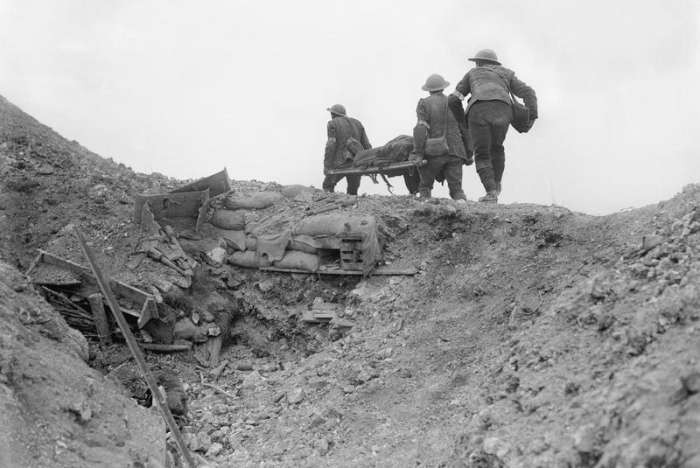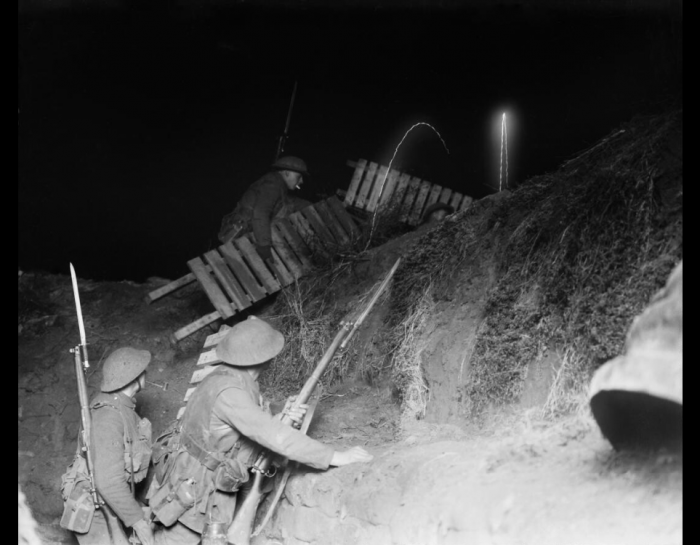
World War I
World War I (1914–18) marked the first great international conflict of the twentieth century. The trauma of the war would profoundly shape the attitudes and actions of both leaders and ordinary people during the Holocaust. The impact of the conflict and its divisive peace would echo in the decades to come, giving rise to a second world war and genocide committed under its cover.
Key Facts
-
1
World War I represented one of the most destructive wars in modern history. More than 8.5 million soldiers died as a result of the hostilities. This exceeded military deaths in all the wars between European powers in the 19th century.
-
2
Punitive treaties were imposed upon the defeated nations (Germany, Austria, Hungary, Bulgaria, and Turkey). The treaties held these powers, particularly Germany, responsible for starting the war and liable for massive material damages.
-
3
The Versailles Treaty of 1919 forced Germany to cede 13 percent of its territory and to largely dismantle its armed forces. Many citizens linked the humiliation of the treaty to the democratic government that replaced the monarchy at the end of the war.
Outbreak of World War I
World War I marked the first great international conflict of the twentieth century. The assassination of Archduke Franz Ferdinand, heir to the Austro-Hungarian crown, and his wife, the Duchess Sophie, in Sarajevo on June 28, 1914, sparked the hostilities. Fighting began in August 1914 and continued on multiple continents for the next four years.
The Allies and Central Powers
The opposing sides in World War I are known as the Allies and the Central Powers.
Allies:
- Britain
- France
- Serbia
- Imperial Russia (also referred to as Tsarist Russia)
- Japan
- Joined later by numerous countries, including Brazil, Greece, Italy, Portugal, Romania, Siam (Thailand), and the United States
Central Powers:
- Germany
- Austria-Hungary
- Joined later by the Ottoman Empire (Turkey) and Bulgaria
The Scope of Fighting

Initially there was enthusiasm on all sides and confidence in a quick and decisive victory. This enthusiasm faded as the war bogged down. It became a stalemate of costly battles and trench warfare, particularly on the European western front.
The system of trenches and fortifications in western Europe extended at its longest some 475 miles. It spread roughly from the North Sea to the Swiss border. For most North American and western European combatants, their experience of the war was trench warfare.
On the other hand, the vast expanse of the eastern front prevented large-scale trench warfare. The scale of the conflict was still equal to that on the western front. Heavy fighting also occurred elsewhere in Europe: in Northern Italy, the Balkans, Greece, and Ottoman Turkey. Combat also took place in Africa, Asia, the Middle East, and the Pacific Islands, at sea and, for the first time, in the air.
Impact of US Entry into the War and the Russian Revolution
A decisive change in the hostilities came in April 1917. Citing Germany's policy of unrestricted submarine warfare and its attempt to ally with Mexico, the United States declared war on Germany on April 6, 1917. Fresh troops and materiel from the American Expeditionary Force (AEF) under the leadership of General John J. Pershing, combined with an ever-tightening blockade of German ports, helped to shift the balance of the war effort eventually to the advantage of the Allies.
This newly gained edge for the Allies was initially counter-balanced by events taking place on the war's eastern front. In 1917, Russia, one of the Allies’ principal powers, was rocked by two revolutions. The first overthrew the imperial government. The second brought the Bolsheviks to power. These events are referred to collectively as the Russian Revolution.
The immediate effect of the Russian Revolution on the European stage was a brutal and enduring civil war in formerly Russian-ruled lands (1917–1922) and the decision of the new Bolshevik leadership to make a separate peace with the Central Powers. This eventually resulted in a peace treaty signed on March 3, 1918, at Brest-Litovsk (today Brest, Belarus). According to this treaty, Russia (then under Bolshevik control) gave up its claims to Finland, Ukraine, Estonia, and Latvia. It also relinquished claims to Polish and Lithuanian territories previously under imperial Russian rule.
Central Powers Surrender
The Treaty of Brest Litovsk freed Germany to concentrate its forces on the western front. By late July 1918, they had advanced to within 50 miles of Paris, leading Kaiser (Emperor) Wilhelm II to assure the German people that victory was in their grasp. In August, however, Allied forces, now reinforced with two million American troops, halted the German offensive and began steadily pushing back the German lines in what would become known as the "Hundred Days' Offensive."
The Central Powers began to surrender, beginning with Bulgaria and the Ottoman Empire, in September and October 1918, respectively. On November 3, Austro-Hungarian forces signed a truce near Padua, Italy. At the end of September, Germany’s military leaders advised the Kaiser that the war was lost and Germany should seek an armistice. On October 4, the German Chancellor telegraphed U.S. President Woodrow Wilson a request to negotiate peace with the Allies. On November 8, the German government sent a delegation led by Catholic Center Party (Zentrum) representative Matthias Erzberger to France to receive and accept the Allies’ terms for ending the war.
Armistice
The news that Germany was suing for peace came as a shock to the German people, leading to disaffection with the government. At the end of October, the mutiny of German sailors in Kiel touched off widespread revolt in German coastal cities and in the major municipal areas of Hannover, Frankfurt on Main, and Munich.1
On November 9, 1918, in the midst of widespread unrest and deserted by the commanders of the German army, the Kaiser abdicated the German throne. On the same day, Social Democratic Party (SPD) delegate Philipp Scheidemann proclaimed Germany a republic, with an interim government led by SPD leader Friedrich Ebert. Two days later, Erzberger met with a delegation of the victorious Allies under French Field Marshal Ferdinand Foch, the commanding general of the Allies’ forces, in a railcar in Compiègne Forest and accepted the armistice terms. The harshness of the terms—which included Allied occupation of Germany’s Rhineland, the surrender to the Allies of the entire German fleet, and the continuation of the naval blockade of Germany—portended the terms of the Treaty of Versailles.
At 11:00 a.m. on November 11 (11/11), 1918, fighting on the western front ceased. The "Great War," as its contemporaries called it, was over. But the far-reaching impact of World War I upon international, political, economic, and social spheres would resonate for decades to come.
Military Losses
World War I represented one of the most destructive wars in history.
More than 8.5 million soldiers died as a result of the hostilities, a figure exceeding the military deaths in all the wars between European powers in the 19th century. Although accurate casualty statistics are difficult to ascertain, an estimated 21 million men were wounded in combat.
The enormous losses on all sides of the conflict resulted in part from the introduction of new weapons and military tactics, such as long-range artillery, tanks, poison gas, and aerial warfare. Military leaders also failed to adjust their tactics to the increasingly mechanized nature of warfare. A policy of attrition, particularly on the western front, cost the lives of hundreds of thousands of soldiers.
July 1, 1916, saw the heaviest loss of life in a single day. On this day, the British Army on the Somme alone suffered over 57,000 casualties.
Germany and Russia incurred the highest number of military deaths: an estimated 1,773,700 and 1,700,000, respectively. France lost sixteen percent of its mobilized forces, the highest mortality rate relative to troops deployed.
Civilian Losses
No official agencies kept careful accounting of civilian losses during the war years, but scholars assert that as many as 13,000,000 non-combatants died as a result of hostilities, mostly from starvation, disease, military action, and massacres. Mortality for both military and civilian populations spiked at war's end with the outbreak of the "Spanish Flu," the deadliest influenza epidemic in history.
Millions of people were uprooted or displaced from their homes in Europe and Asia Minor as a result of the conflict. Property and industry losses were catastrophic, especially in France and Belgium, where fighting had been the heaviest.
Critical Thinking Questions
Some historians write that World War I (the Great War) was avoidable. What institutions and ideas developed after 1919 to prevent a recurrence? Why did they fail by 1939?
How did World War I change the face of modern warfare? Did the warring parties violate or ignore understandings about tactics and weapons? Were any international agreements violated or ignored?
International agreements have a mixed record of success in terms of limiting or preventing dangerous behavior by individual nations. How can this be improved or changed?

